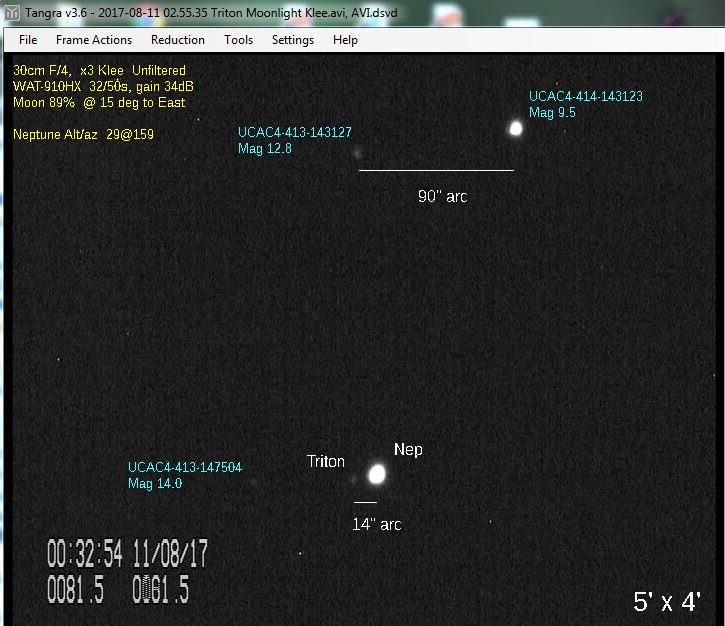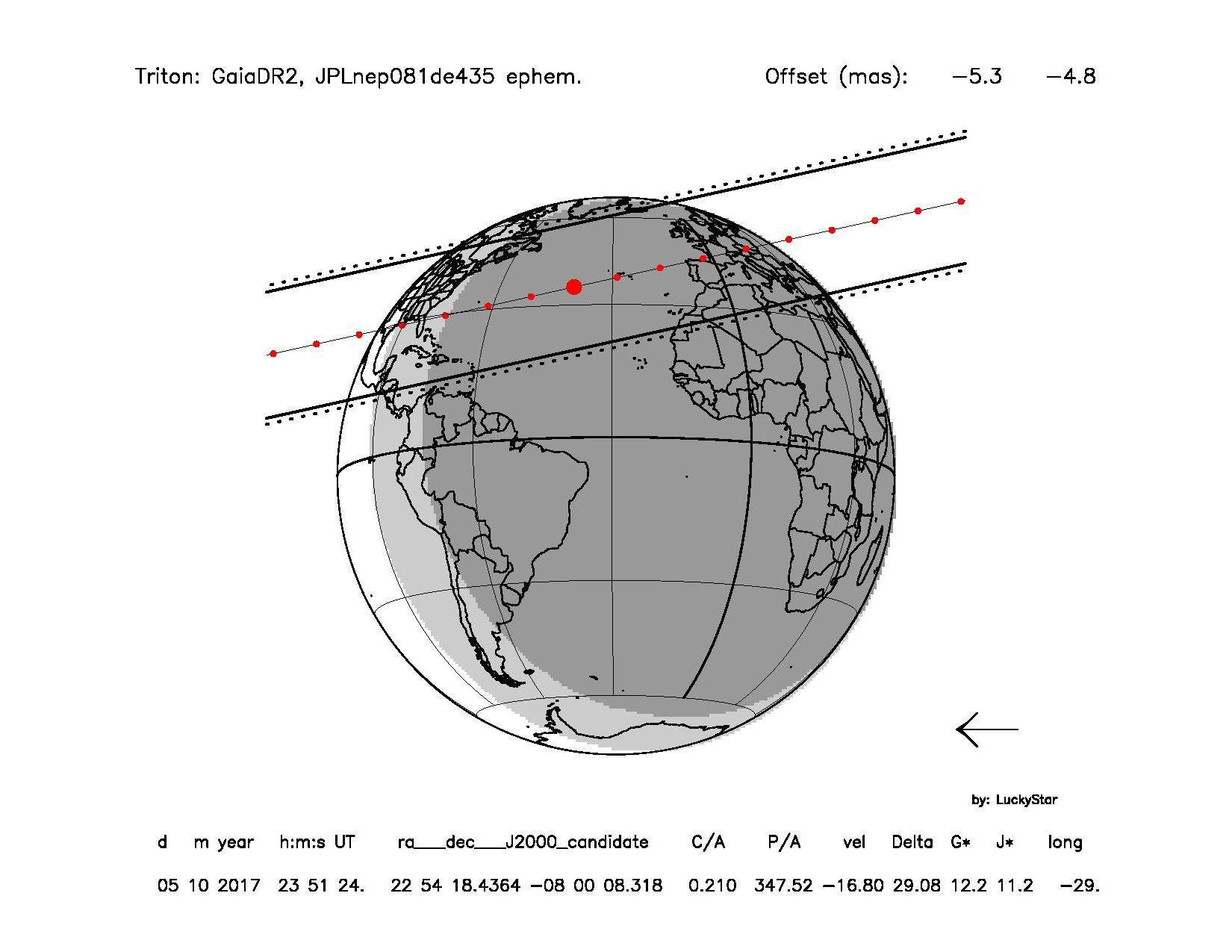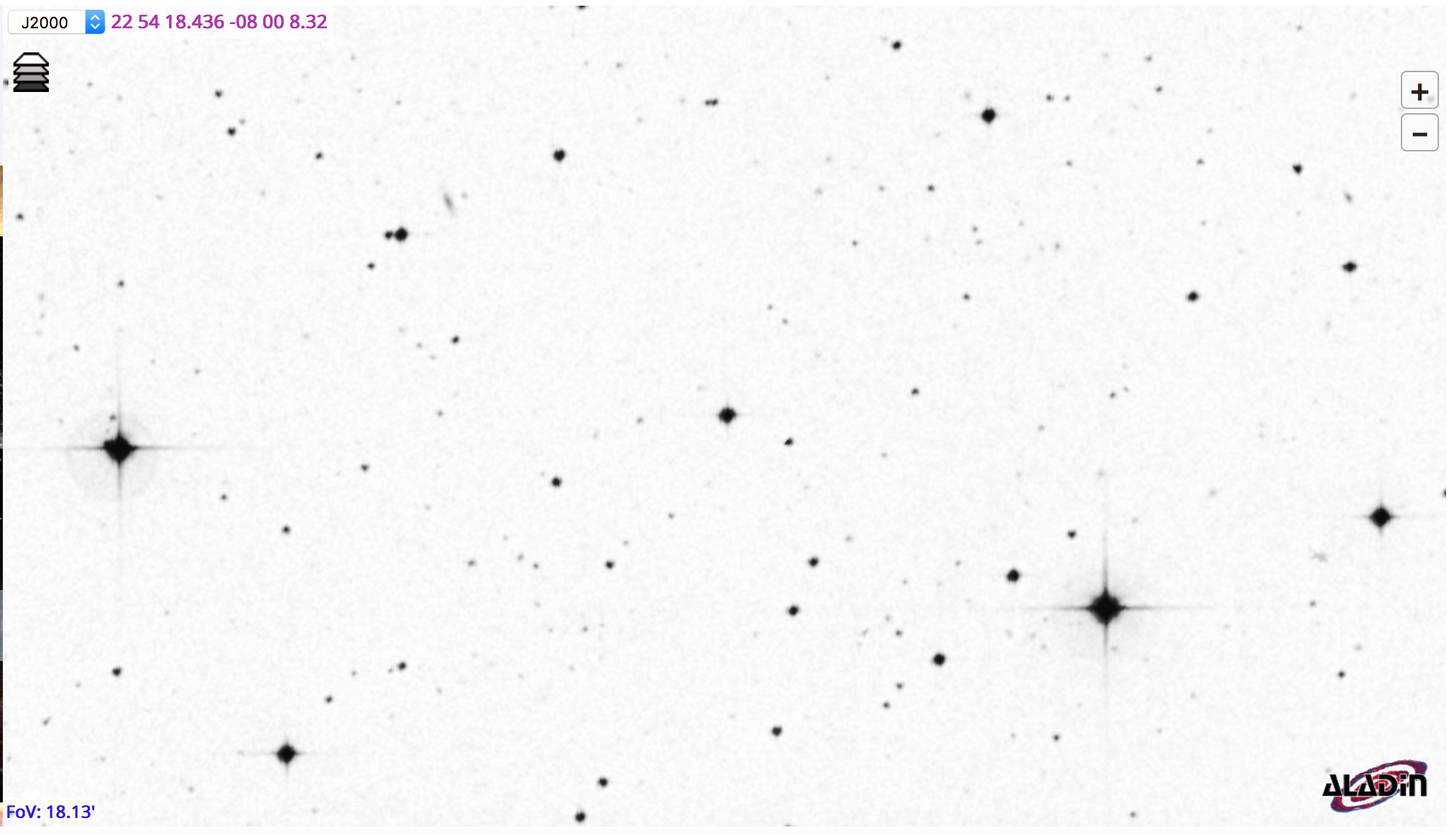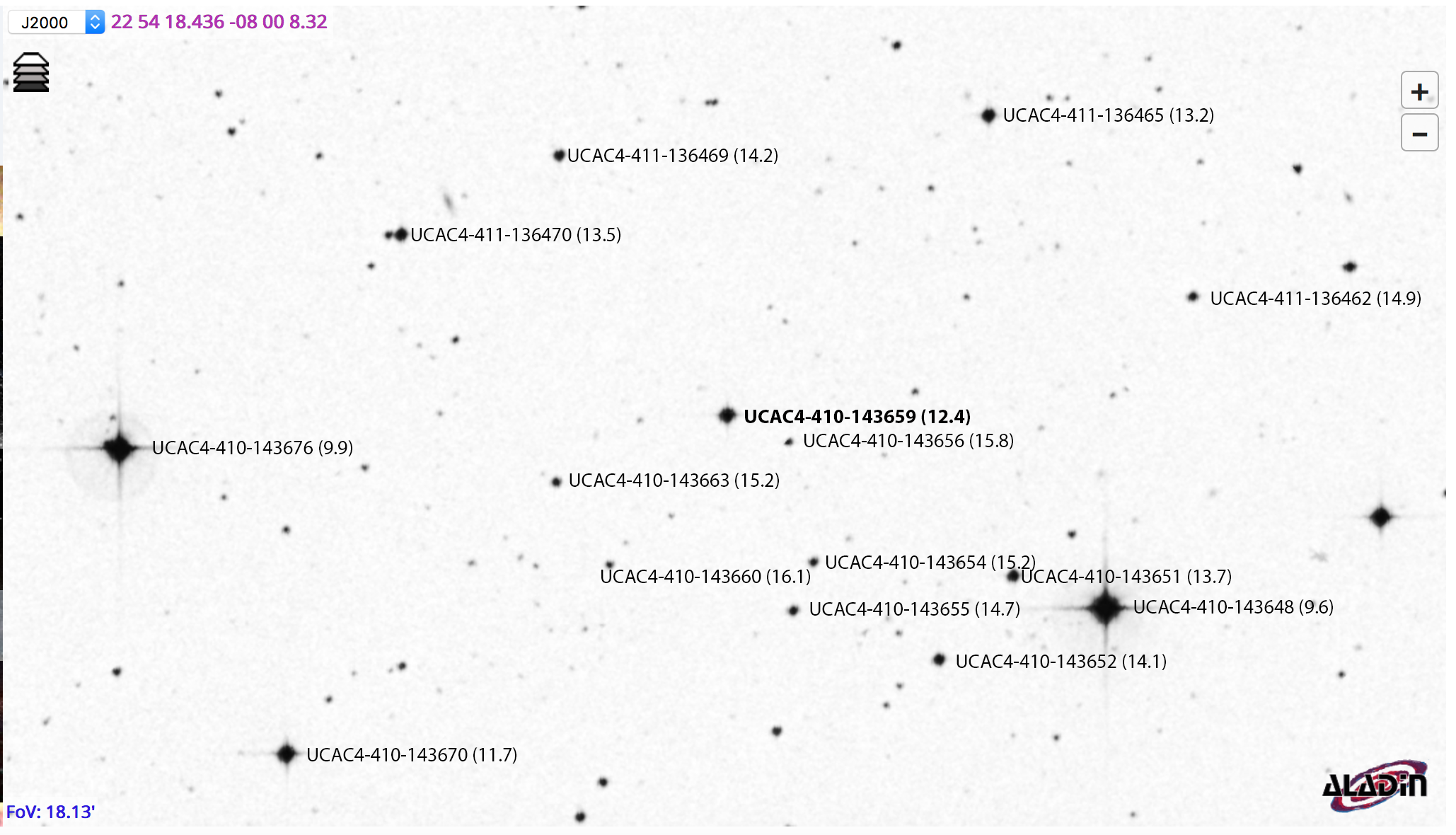Triton
occulted UCAC4 410-143659, night of 2017 Oct 5th/6th
~ predicted by the Lucky-Star Project Team ~
https://observatoiredeparis.psl.eu/lucky-star.html
An
observation planned by Tim Haymes:
[ STARGAZER HOME]
Last update: 2017-10-04. Conclusion updated 2019 June 25
..
Weather permitting I will be attempting this observation by VIDEO using a 30cm F/4 Newtonian and Barlow (or Powermate). The detector is a WAT-910HX (8 bit Video) with GPS time insertion. I record to a Sony TRV22E digital camcorder (1985 tech). The Mount is EQ6 controlled by SkyMapPro (via EQMod). This page summarises my observation planning and tests. Its a rare event and will be above my local horizon at +27/208. Clear skies have been requested !
A large number of observers across Europe will be hoping to record the event. Since the star is brighter than Triton its likely that the star will be seen and this will disappear during the occultation.
Four tests presented (updated on Aug 11 th) and new updates from the Luck Star project.
Object: Triton (I) (Moon of Neptune) occults UCAC4 410-143659
RA-DEC 22 54 18.4 -08 00 8.3 (J2000)
UT of central occultation: 2017 Oct 5th 2349UT - do check for any updates.
[....] image removed
Date: Thursday
October 5th - Central Time ~ 2349 UT (UK)
UT:.... Suggested recording
duration: 2339 - 2359 UT (Note: Professionals
indicate +/- 20 to 30 min around 2349 UT just to be sure )...
Mag drop :
.........1.4
v ..(1.1r)
Star Magnitude: 12.7v 12.5r
Triton Mag: . ......13.5v
12.9r
Combined Magnitude
about 12.3
Maximum expected duration: 161 sec
Location: ..........UK,
Europe, N Africa, US East coast.
Local Alt/Az:....
+27 @ 208 (52N, 001W)
Path UPDATE 2017 Sep26 : Josselin Desmars communicates that astrometry of Triton from Brazilian collegues over an 8 day period produced a slight offset to the DE435+NEP081 ephemeris that amounts to a few milli-arc seconds. This is good, as the projection on Earth is close to prevous paths. The predicted central flash zone passes over southern France.
New
**Path
UPDATE 2017 Oct 4th**
Josselin Desmars communicates that Marcelo Assafin (from Brazil) was able
to re reduce the observations using Gaia DR2 positions.
He derived a new offset :RA ( x cos delta) = 7.8 mas +/- 5.4 mas, DEC
= -17.6 +/- 2.6 mas.
The new offset is more robust and leads to an uncertainty of 120km in projected distance and 8 sec in time.
The new prediction is now more in the south (with a centrality mainly
above Portugal, Spain, Italy, ...)
Update of Sept 26 ............................................................Update of Oct 4th
Additional
charts, courtesy
of B. Sicardy: 18 'x 13' indicating field stars around UCAC4-410-143659
(12.4) [occulted]
( These maps are best viewed in a separate window:- i.e. right
click and open in new tab)
credits: Sky
Map Pro software, and WinJupos
SkyMap with
target star and Triton. 10"
= a quarter of the diameter of Jupiter only.
Location of
Triton from WinJupos
Using the database by Mike Kretlow (IOTA-ES):
Observing considerations:
1) Do test runs to establish
optimum settings to detect Triton.
Test runs are best done on nights prior to
that of the occultation, as well as during the run-up to the occultation
itself. The star is brighter than
Triton, so it is worth while to give the event a try
!
2) The planet is 100x brighter, so Neptune will create unwanted light:
CCDs often produce leakage along the pixel
columns (and sometimes along the row direction), so it is sometimes
beneficial to turn the camera to minimise overlap of stray light interfering
with the image of Triton, rather than having it aligned in RA and DEC.
The WinJupos plot (above) indicates Triton is at PA (about) 110 degrees.
3) Will Moonlight effect visibility ? The event happens just 5 hours after the Moon is full and quite close to perigee, and higher in the sky than Neptune. With an angular separation of 34 degrees, it may be worth observers erecting a temporary 'moon shade' to stop moonlight entering the telescope aperture. It might mean the difference between success or failure for observers using relatively small apertures.
4) A telescope with long focal length will produce best results. e.g. SCT: There are fewer diffraction effects, and contrast should improve, so a SCT would be a good system to use.
5) Is use of a Barlow lens is indicated ? The Neptune / Star separation is 10" arc so a Barlow will increase the image scale. Getting good focus on the star will also be important. It may not be easy in poorer seeing, but if the star is recorded then we may get a result. Use of a Barlow should be part of the test.
6) Take as many short exposures as possible. Subsecond exposures between 0.16 to 0.64 sec are desirable depending on sky conditions and the aperture used.
7) Aim for good sensitivity.
i.e. Triton+Star are detected clearly. If
necessary longer exposures should be used e.g. 1 to 2 sec in order to
capture the star.
8) If possible, use a 12-16bit FITS, otherwise 8bit AVI: Part
of the extended test. This observer will use 8bit analogue video to
(AVI) to start with.
9) Use of a USB planetary web cam requires the clock be Sync 'ed with
Dimension4 (Thinking Man Software) or similar for NTP. Correct
computer time is important.
10) Suggested software is: FireCapture or SharpCap for time stamping
(or use an established method): Planetary
web cams are useful, but the user will need to establish their sensitivity
using a trial run.
11) It's not thought that filters will improve detection for this event: Since the planet is blue/green, the option would be a red filter. But since the spectral type of the star is not given, filtration may not provide any benefit.
12) Addendum to filtration: I am tempted to try a light green W11 filter during the test phase. (Wratten Filters). The use of an Atmospheric Dispersion Corrector might improve the detection limit by sharpening the image.
1 - RESULTS FROM TEST VIDEO-ING
ON 2017 JULY 21 @ 0227UT
Note
to the above image:
This was a 30cm F4 and 5x Powermate, with WAT-910HX Setting x32, 39dB
gain (=0.64s).
The camera was pre-focused with a Bahtinov mask using alpha And. Stability
was Ant iii (not good, not bad either).
A single integrated frame (0.64s) was selected for this illustration.
2
- RESULTS of TEST with a University KLEE 2.8 x Barlow
2017 July 26, 0200UT
compared to NO Barlow (Filtered with Wratten 11)
Below: No Barlow. Native focal length is 1200mm @ F/4
Notes to the above test-2 images
By comparison with the first test, the KLEE Barlow [1] gave about the same amplification as a 5 x Powermate [ FL 6m ]. This was explained by the fact the WATEC CCD with nose piece and filter was positioned 35 mm from the normal eyepiece focal plain. This increased the amplification to about 4.5 (or 5). From an approximate calculation [2] the focal length of the KLEE was 25mm (1 inch). Much shorter than most other Barlows. With this in mind I measured a Revelation Astro ED 2x Barlow (2" fit) and found this to have a focal length of 100mm.
[1] Loaned by Adrian Jones (Maidenhead AS)
[2] J. B. Sidgwick, Amateur Astronomer's Handbook. 2nd ed 1960
Tangra Light Curve from the
avi
using 16/50s, gain 34dB NO Barlow, W 11 filter, with "pixels in
the background annulus" reduced from 350 to 100 (Tangra>settings>photometry).
3
- RESULTS of TEST with an 2x ED-Barlow on 2017 July 28, 0200UT
with Wratten 11 (pale yellow-green)
Notes to the above
test-3 images
Smaller angular separation from Planet (10-12") due to orbit. Scale
is 0.7 arcsec / pixel. Wider field of view ( 7' x 9' ) so periodic error
is less obvious. A single field star of Mag 13.5 was available as a
guide star for the photometric software. Seeing stability was poorer
compared to previous test images
4
- RESULTS of TEST with a 1.25" KLEE x2.8 Barlow on
2017 Aug 12, 0030UT
with and without Wratten 11 (pale yellow-green).
In Moon light [89% 15d to East]

Notes: Triton is magnitude 13.5. The star UCAC4-413-143127 is 1/3rd
mag fainter than the occulted star (Not in the image). This is an
unfiltered CCD video in transparent conditions (no cloud or haze)
but seeing stability was poor. I estimated the seeing disk from 2
to 4" arc variation. The effect of the Moon nearby at 15deg.
distant and similar altitude is now causing a noticeable increase
in background noise event at F12 effective focal ratio. Even so the
integrated frame of 0.64s clearly shows Triton above noise level.
.........
..........
1)Signal to Noise unfiltered.........2) Target star (mag 12.4).........3)Effect
of adding theW11 filter
Notes: Signal to noise was estimated with TANGRA. Three
screen captures are compared.
(1) Unfiltered: An area of blank sky (green line) was compared
to Triton (Blue line). The StN was 9 and the uncalibrated mean intensity
is about 1700
(2) Unfiltered: An area of blank sky (yellow) was compared
to the predicted target star. The StN was 25 and the uncalibrated
mean intensity is about 2500
(2) Wratten 11: Comparison
of Triton (blue) with field stars. The StN on Triton had dropped to
about 5, and the uncalibrated mean intensity is about 1300.
Conclusion:
The W11 filter subtracts too much light with no added benefit (that
could be seen). The presence of Moon light suggested that the best
StN is required (i.e No Filter).
2017-09-22:
Remarks made at ESOP36 (Freiberg) suggest that the over amplifiction
(e.g. Barlow) will lead to lose of sensitivity. The reason is that
the light will be spread across too-many pixels (depending on the
instrument and camera). This could be offset by binning. The field
of view should idealy contain a photometric comparison star of R10-12
mag
An exposure time of 1 to 2 seconds would also record the event with usable definition of Triton's diameter.
It was also suggested at the Symposium, that data aquisition on the star alone (while not occulted ) would allow more accurate photometric results.This could be obtained during the hours leading up to the event provided Neptune was at a similar altitude. (about 25 to 29 deg ?) or possibly the day before under the same conditions,
There will also be two field stars (9.9 and 9.6 magnitude)
for comparison or seeing control. See the additional
charts above.
The star UCAC4-410-143670 (11.7 mag) is about optimum for photometric
comparison
2017-09-26:
An updated ephemeris for Triton indicates no significant change in
the predicted shadow path.
2017-10-06 CONCLUSION
The occultation
was recorded in clear conditions from 51.5N, 0.8W. Seeing was poor.
Mid altitude fast-moving cloud was in the area, but stayed away apart
from a brief intetuption in the first few seconds of the recording.
The target remained visible dispite the cloud. The final instrument
configuration was:
30cm F/4 Newtonian on EQ6pro controled by SkyMap
Pro V11 via EQdirect.EQMod
WAT-910HX/RC serial number >1000
Gain 38dB
Integration 640ms
Vixen 1.25" 2x Barlow => F10
Wratten 25 (red) filter
*ION (Video For Ever) A-to-D USB converter
Windows 7 Home (novatech) (New line)
OccuRec recorder in AAV format (Hristo Pavlov)
Analysis of the AAV with Tangra 3.6.12 (Hristo Pavlov)
Dark
frames and a sequence taken 1.5hr before the event showing the star
and moon separated were also recorded.
The AAV was converted to FITS for Bruno Sicardy to analyse.
Light Curve: Duration (50% flux) of 142s +/-3s. Guide/comparison star is plotted in yellow (v11.7 mag)
The observation was reported.


